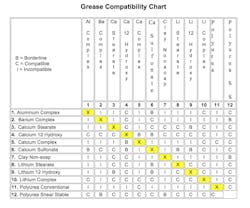Q: How important is it to regularly grease my truck?
A: It’s extremely important. Grease is one of the least expensive investments you can make to protect your equipment. A $3 tube of grease every 12,000 miles is a small investment to protect your equipment.
Grease is responsible for two things: protecting and lubricating equipment and preventing dirt and water from getting in and damaging metal surfaces. If grease is not regularly applied, you don’t have the constant reconfirming of the protective layer of the metal. Not only does that allow potential for wear because of lack of lubrication, but you also lack protection against the water, dirt and corrosive deicers coming off the road.
Q: What should I look for when selecting grease?
A: The most important thing to know about grease is the thickener. Thickeners, which are made of materials like lithium, calcium, polyurea, etc., make grease pasty, and certain thickeners are not compatible with each other. Of the approximately 10 different thickeners, about half of them are incompatible with other thickeners.
Mixing incompatible greases will lead to ineffective lubrication, as the chemistries react with each other and disassemble. The different raw materials will begin to separate, and the greases may exhibit abnormal oil separation.
I saw this happen in a company’s central greasing system. When they pressed the trigger of the automatic grease gun, a new color would come out every time. Because the two greases in the system were incompatible, the base oil separated out. The lubrication materials for friction and wear separated. The color separated. It was all sitting in the tank but in different layers, like looking through a kaleidoscope.
Q: Does the color of grease make a difference?
A: Most people get fixated on a color. They say, I have to have a red grease. But in fact, red greases aren’t all the same. There are about a dozen different reds, but they are not all compatible. It’s about thickener and quality, not color.
We recommend that drivers and equipment owners use their phone to snap a photo of their grease’s label and bring it to their grease supplier. They’ll find a product that’s compatible and of high quality. It’s amazing how quickly equipment will begin to show wear when inferior grease is applied on top of quality grease.
Learn more about CENEX COMMERCIAL FLEET GREASES.




